SLVS905A December 2008 – October 2017 TLV431A-Q1 , TLV431B-Q1
PRODUCTION DATA.
- 1 Features
- 2 Applications
- 3 Description
- 4 Revision History
- 5 Pin Configuration and Functions
- 6 Specifications
- 7 Parameter Measurement Information
- 8 Detailed Description
- 9 Applications and Implementation
- 10Power Supply Recommendations
- 11Layout
- 12Device and Documentation Support
- 13Mechanical, Packaging, and Orderable Information
パッケージ・オプション
メカニカル・データ(パッケージ|ピン)
サーマルパッド・メカニカル・データ
発注情報
9 Applications and Implementation
NOTE
Information in the following applications sections is not part of the TI component specification, and TI does not warrant its accuracy or completeness. TI’s customers are responsible for determining suitability of components for their purposes. Customers should validate and test their design implementation to confirm system functionality.
9.1 Application Information
Figure 25 shows the TLV431A, or TLV431B used in a 3.3-V isolated flyback supply. Output voltage VO can be as low as reference voltage VREF (1.24 V ± 1%). The output of the regulator, plus the forward voltage drop of the optocoupler LED (1.24 + 1.4 = 2.64 V), determine the minimum voltage that can be regulated in an isolated supply configuration. Regulated voltage as low as 2.7 Vdc is possible in the topology shown in Figure 25.
The 431 family of devices are prevalent in these applications, being designers go to choice for secondary side regulation. Due to this prevalence, this section will further go on to explain operation and design in both states of TLV431 that this application will see, open loop (Comparator + Vref) & closed loop (Shunt Regulator).
Further information about system stability and using a TLV431 device for compensation can be found in the application note Compensation Design With TL431 for UCC28600, SLUA671.
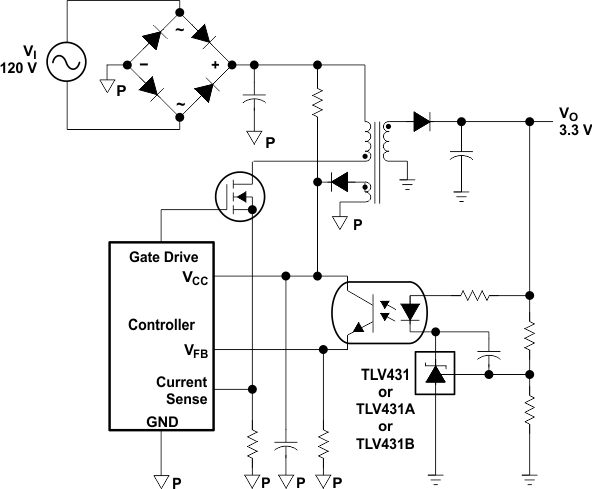 Figure 25. Flyback With Isolation Using TLV431, TLV431A, or TLV431B
Figure 25. Flyback With Isolation Using TLV431, TLV431A, or TLV431B as Voltage Reference and Error Amplifier
9.2 Typical Applications
9.2.1 Comparator with Integrated Reference (Open Loop)
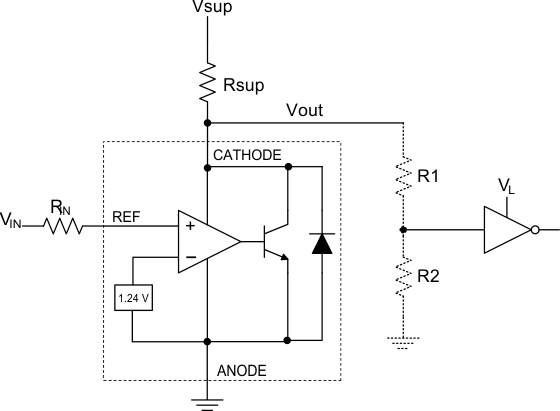 Figure 26. Comparator Application Schematic
Figure 26. Comparator Application Schematic
9.2.1.1 Design Requirements
For this design example, use the parameters listed in Table 1 as the input parameters.
Table 1. Design Parameters
| DESIGN PARAMETER | EXAMPLE VALUE |
|---|---|
| Input Voltage Range | 0 V to 5 V |
| Input Resistance | 10 kΩ |
| Supply Voltage | 5 V |
| Cathode Current (Ik) | 500 µA |
| Output Voltage Level | ~1 V - Vsup |
| Logic Input Thresholds VIH/VIL | VL |
9.2.1.2 Detailed Design Procedure
When using TLV431 as a comparator with reference, determine the following:
- Input voltage range
- Reference voltage accuracy
- Output logic input high and low level thresholds
- Current source resistance
9.2.1.2.1 Basic Operation
In the configuration shown in Figure 26 TLV431 will behave as a comparator, comparing the Vref pin voltage to the internal virtual reference voltage. When provided a proper cathode current (Ik), TLV431 will have enough open loop gain to provide a quick response. With the TLV431's min Operating Current maximum (Imin) being 55 uA to 100 uA over temperature, operation below that could result in low gain, leading to a slow response.
9.2.1.2.2 Overdrive
Slow or inaccurate responses can also occur when the reference pin is not provided enough overdrive voltage. This is the amount of voltage that is higher than the internal virtual reference. The internal virtual reference voltage will be within the range of 1.24V ±(0.5% or 1.0% ) depending on which version is being used.
The more overdrive voltage provided, the faster the TLV431 will respond. This can be seen in figures Figure 27 and Figure 28, where it displays the output responses to various input voltages.
For applications where TLV431 is being used as a comparator, it is best to set the trip point to greater than the positive expected error (i.e. +1.0% for the A version). For fast response, setting the trip point to > 10% of the internal Vref should suffice.
For minimal voltage drop or difference from Vin to the ref pin, it is recommended to use an input resistor < 10 kΩ to provide Iref.
9.2.1.2.3 Output Voltage and Logic Input Level
In order for TLV431 to properly be used as a comparator, the logic output must be readable by the recieving logic device. This is accomplished by knowing the input high and low level threshold voltage levels, typically denoted by VIH & VIL.
As seen in Figure 27, TLV431's output low level voltage in open-loop/comparator mode is ~1 V, which is sufficient for some 3.3V supplied logic. However, would not work for 2.5 V and 1.8 V supplied logic. In order to accommodate this a resistive divider can be tied to the output to attenuate the output voltage to a voltage legible to the receiving low voltage logic device.
TLV431's output high voltage is approximately Vsup due to TLV431 being open-collector. If Vsup is much higher than the receiving logic's maximum input voltage tolerance, the output must be attenuated to accommodate the outgoing logic's reliability.
When using a resistive divider on the output, be sure to make the sum of the resistive divider (R1 & R2 in Figure 26) is much greater than Rsup in order to not interfere with TLV431's ability to pull close to Vsup when turning off.
9.2.1.2.3.1 Input Resistance
TLV431 requires an input resistance in this application in order to source the reference current (Iref) needed from this device to be in the proper operating regions while turning on. The actual voltage seen at the ref pin will be Vref=Vin-Iref*Rin. Since Iref can be as high as 0.5 µA it is recommended to use a resistance small enough that will mitigate the error that Iref creates from Vin.
9.2.1.3 Application Curves
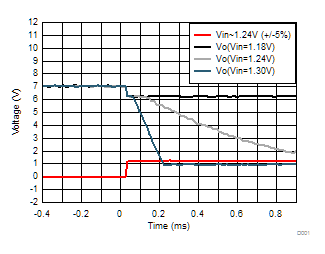 Figure 27. Output Response with Small Overdrive Voltages
Figure 27. Output Response with Small Overdrive Voltages
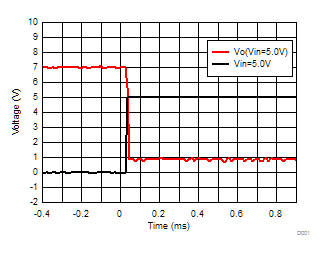 Figure 28. Output Response with Large Overdrive Voltage
Figure 28. Output Response with Large Overdrive Voltage
9.2.2 Shunt Regulator/Reference
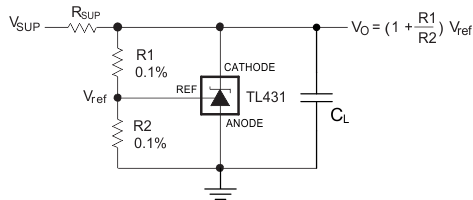 Figure 29. Shunt Regulator Schematic
Figure 29. Shunt Regulator Schematic
9.2.2.1 Design Requirements
For this design example, use the parameters listed in Table 2 as the input parameters.
Table 2. Design Parameters
| DESIGN PARAMETER | EXAMPLE VALUE |
|---|---|
| Reference Initial Accuracy | 1.0% |
| Supply Voltage | 6 V |
| Cathode Current (Ik) | 1 mA |
| Output Voltage Level | 1.24 V - 6 V |
| Load Capacitance | 100 nF |
| Feedback Resistor Values and Accuracy (R1 & R2) | 10 kΩ |
9.2.2.2 Detailed Design Procedure
When using TLV431 as a Shunt Regulator, determine the following:
- Input voltage range
- Temperature range
- Total accuracy
- Cathode current
- Reference initial accuracy
- Output capacitance
9.2.2.2.1 Programming Output/Cathode Voltage
In order to program the cathode voltage to a regulated voltage a resistive bridge must be shunted between the cathode and anode pins with the mid point tied to the reference pin. This can be seen in Figure 29, with R1 & R2 being the resistive bridge. The cathode/output voltage in the shunt regulator configuration can be approximated by the equation shown in Figure 29. The cathode voltage can be more accuratel determined by taking in to account the cathode current:
VO=(1+R1/R2)*Vref–Iref*R1
In order for this equation to be valid, TLV431 must be fully biased so that it has enough open loop gain to mitigate any gain error. This can be done by meeting the Imin spec denoted in Recommended Operating Conditions table.
9.2.2.2.2 Total Accuracy
When programming the output above unity gain (Vka=Vref), TLV431 is susceptible to other errors that may effect the overall accuracy beyond Vref. These errors include:
- R1 and R2 accuracies
- VI(dev) - Change in reference voltage over temperature
- ΔVref / ΔVKA - Change in reference voltage to the change in cathode voltage
- |zKA| - Dynamic impedance, causing a change in cathode voltage with cathode current
Worst case cathode voltage can be determined taking all of the variables in to account. Application note SLVA445 assists designers in setting the shunt voltage to achieve optimum accuracy for this device.
9.2.2.2.3 Stability
Though TLV431 is stable with no capacitive load, the device that receives the shunt regulator's output voltage could present a capacitive load that is within the TLV431 region of stability, shown in Figure 18. Also, designers may use capacitive loads to improve the transient response or for power supply decoupling.
9.2.2.3 Application Curves
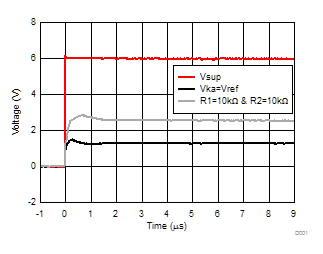 Figure 30. TLV431 Start-Up Response
Figure 30. TLV431 Start-Up Response